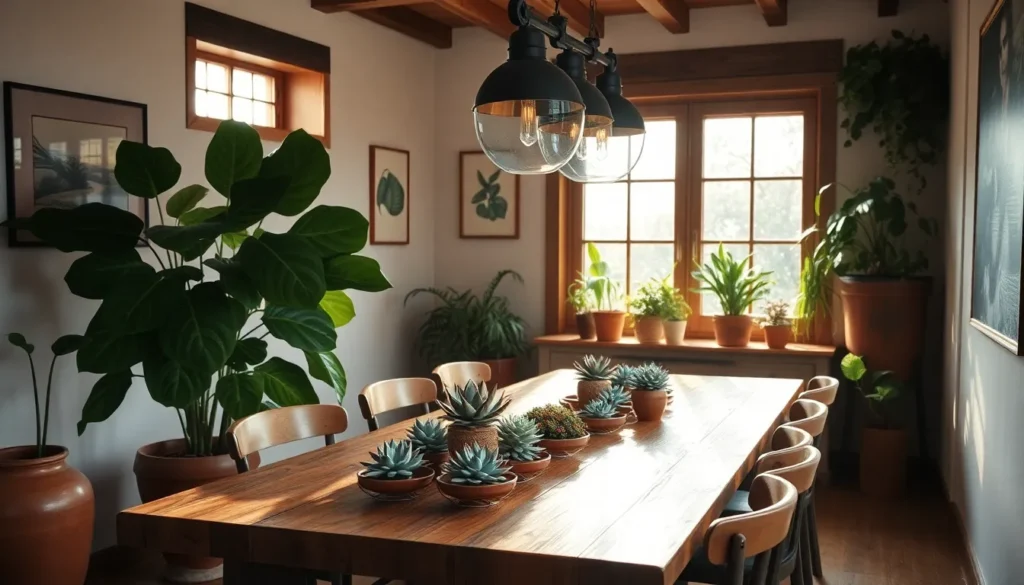We’ve all walked into a dining room and felt something was missing – that spark of life that transforms a simple eating space into a vibrant gathering place. The secret lies in bringing nature indoors through carefully chosen plants that don’t just fill empty corners but create an atmosphere that makes every meal feel special.
Plants in dining rooms aren’t just decorative elements; they’re natural mood enhancers that purify the air while adding texture color and personality to our most social spaces. Whether you’re hosting intimate family dinners or entertaining friends we’ve discovered that the right botanical choices can turn your dining area into a restaurant-quality experience.
From low-maintenance succulents that thrive in bright windows to statement plants that become conversation starters we’ll show you how to select position and care for dining room plants that complement your style and lifestyle. Get ready to transform your dining space into a lush inviting sanctuary where great food meets great atmosphere.
Transform Your Dining Room With Plants for a Fresh, Inviting Atmosphere
Plants strategically placed throughout your dining room create an immediate transformation that guests notice the moment they enter. We’ve discovered that incorporating greenery into dining spaces requires a thoughtful approach that balances aesthetics with functionality.
Assess your dining room’s natural light conditions first. South-facing windows provide the brightest illumination, making them perfect for light-loving plants like fiddle leaf figs or monstera deliciosa. North-facing dining rooms receive gentler, indirect light that suits pothos, snake plants, and ZZ plants beautifully.
Position larger statement plants in corners to anchor your dining room design. Floor-standing planters with tall plants like bird of paradise or rubber trees create dramatic focal points without overwhelming your dining table. These substantial plants fill empty corners while adding height and visual interest to your space.
Create layers using plants of varying heights throughout your dining room. Tall floor plants, medium-sized tabletop arrangements, and hanging plants establish depth and dimension. This layering technique makes your dining room feel more spacious while adding natural texture to every sight line.
Choose plants that complement your existing dining room color palette. Deep green foliage from snake plants or monstera leaves enhances neutral dining room schemes, while colorful plants like crotons or flowering varieties add vibrant accents to monochromatic spaces.
Install hanging planters to maximize your dining room’s vertical space. Ceiling-mounted or wall-hanging plants like trailing pothos or string of hearts draw the eye upward, making your dining room appear larger. These elevated plants also keep your dining table surface clear for meals and entertaining.
Select plants that thrive in your dining room’s exact humidity levels. Dining rooms often experience temperature fluctuations from cooking activities, so choose resilient plants like peace lilies or philodendrons that adapt well to changing conditions while continuing to purify your air.
Group plants in odd numbers to create naturally appealing dining room arrangements. Clusters of three or five plants in complementary pots establish visual harmony while avoiding overly symmetrical displays that can feel rigid in dining spaces meant for relaxation and conversation.
Choose the Right Plants for Your Dining Room Environment
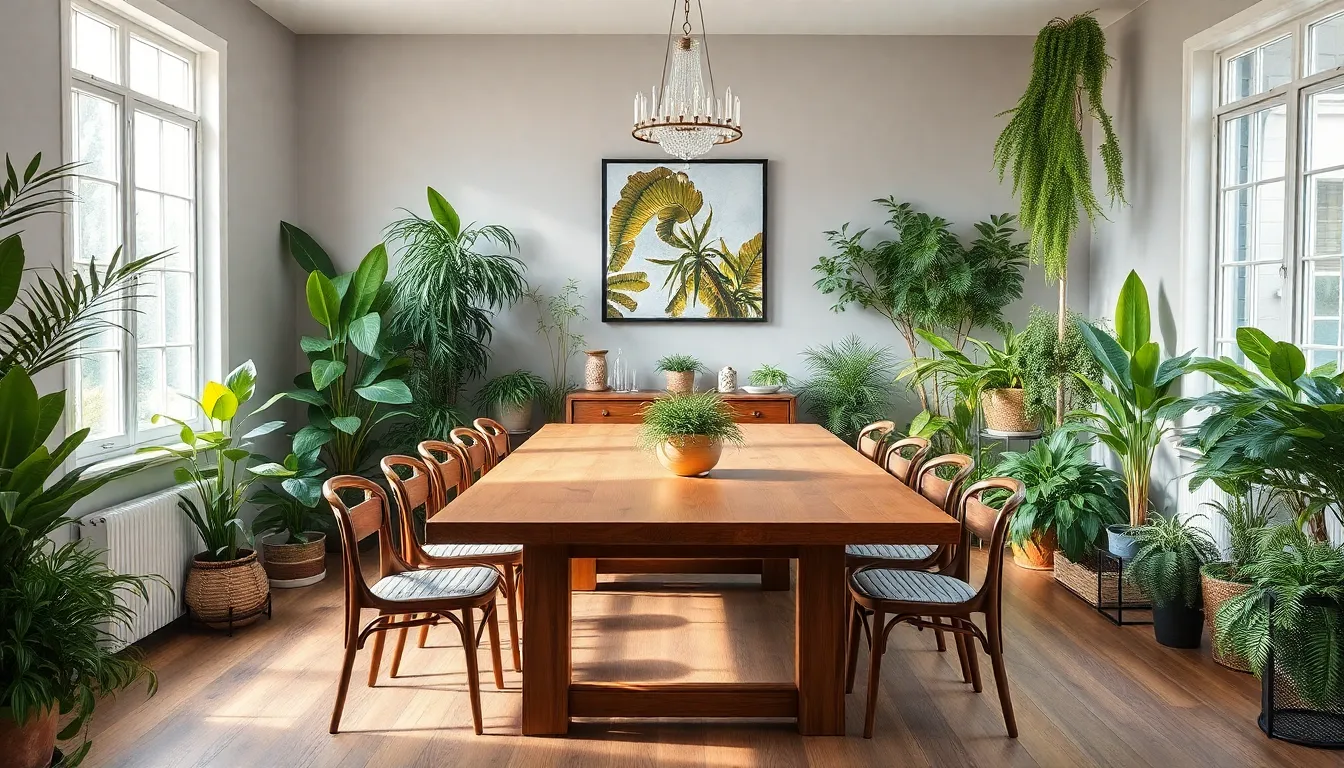
Building on our assessment of natural light, we’ll now explore exact plant varieties that thrive in different dining room conditions. Matching plants to your environment ensures they flourish and maintain their beauty throughout the seasons.
Consider Light Conditions and Window Placement
Light conditions determine which plants will succeed in your dining room space. Direct sunlight from large windows or skylights creates perfect conditions for sun-loving varieties like croton, succulents, cacti, and yucca plants that soak up full sun exposure.
Bright indirect light from east or west-facing windows supports a wider range of options including palms, dracaena, lucky bamboo, ficus, nerve plant, hoya, and zebra plant. These varieties appreciate filtered light without harsh afternoon rays.
Low light environments in north-facing or dimmer dining rooms call for shade-tolerant champions like snake plants, ZZ plants, calathea, ferns, and orchids. Window orientation affects light intensity throughout the day, so we recommend observing your room’s patterns before selecting plants.
Plants positioned on tables or near windows can serve as living centerpieces while adding texture to darker wood tones or creating visual interest in neutral spaces.
Select Pet-Safe and Non-Toxic Plant Varieties
Pet safety should guide our plant selections when furry family members share our dining spaces. Non-toxic options like lucky bamboo and certain ferns provide greenery without risking accidental poisoning if pets decide to nibble.
Avoid harmful varieties including some ficus species and exact dracaena types that can cause digestive issues or other health problems for cats and dogs. Research each plant’s toxicity level before bringing it into homes with pets.
Consider placement height as an additional safety measure, positioning potentially harmful plants on high shelves or hanging planters where curious pets can’t reach them.
Factor in Maintenance Requirements and Your Lifestyle
Your available time and gardening experience should influence plant choices for long-term success. Low maintenance champions like snake plants and ZZ plants require minimal watering and tolerate neglect beautifully, making them perfect for busy schedules or frequent travelers.
Higher maintenance beauties such as orchids demand more attention with exact humidity levels, regular feeding schedules, and careful watering routines. These plants reward dedicated care with stunning blooms and lush foliage.
Honest assessment of your lifestyle prevents plant disappointment and keeps your dining room looking vibrant. Choose varieties that align with your care capabilities rather than aspirational gardening goals that may lead to stressed or dying plants.
Position Plants Strategically Throughout Your Dining Space
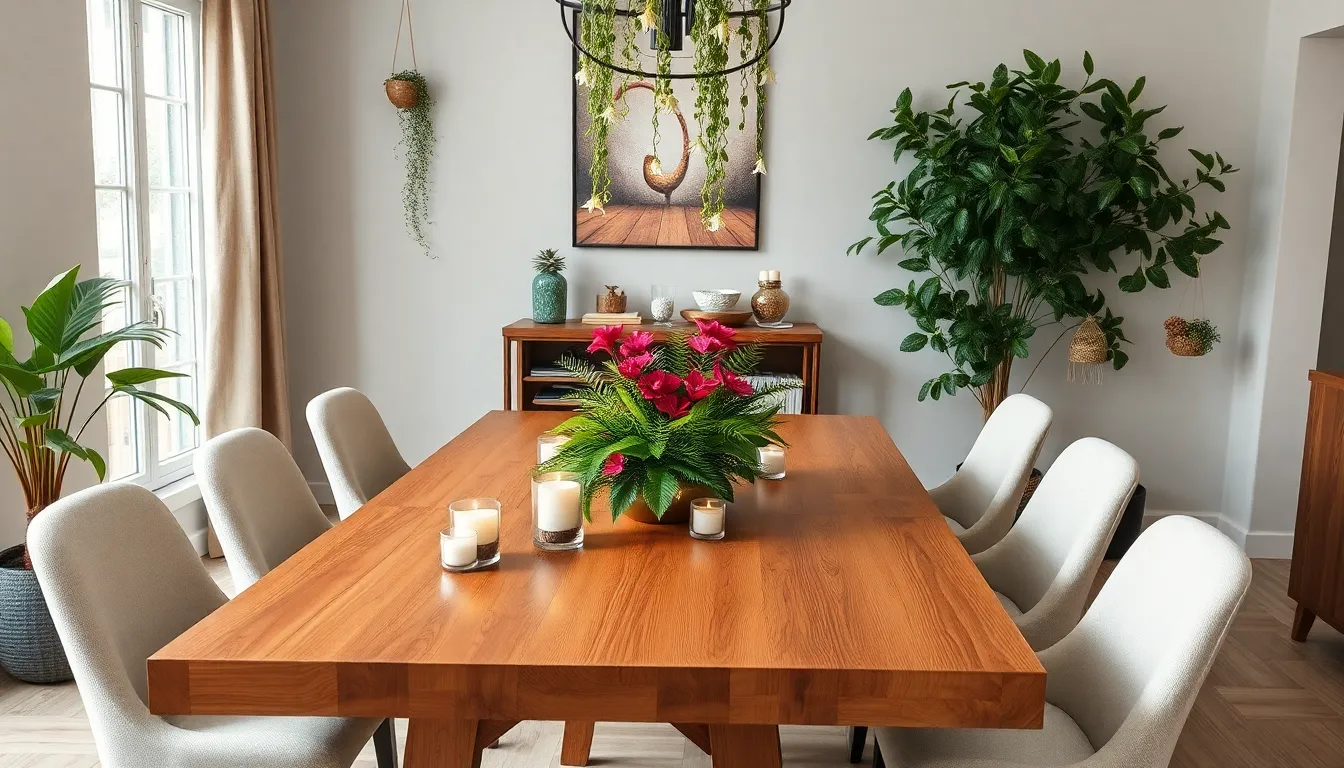
Strategic placement transforms your dining room into a natural sanctuary while ensuring your plants receive optimal growing conditions. We’ll show you how to maximize both visual impact and plant health through thoughtful positioning.
Create a Stunning Centerpiece With Table Plants
Ferns make exceptional dining table centerpieces, bringing lush greenery and rich texture to your meals. Rex begonias offer another stunning option with their vibrant foliage patterns that capture attention without overwhelming conversation. We recommend combining smaller plants with decorative elements like candles or seasonal accents to create festive, evergreen table compositions that evolve throughout the year.
Table centerpieces serve as natural focal points that transform your dining experience from ordinary to extraordinary. Plants positioned at eye level create intimate connections with nature during meals while maintaining the perfect scale for conversation. Remember to choose plants that won’t obstruct views across the table, keeping arrangements low enough for easy interaction.
Use Corner Spaces for Floor Plants
Larger palms transform unused dining room corners into striking vertical displays that add natural drama. Dracaenas thrive in these spaces, offering sculptural forms that complement modern and traditional dining rooms alike. Indoor trees like fiddle leaf figs or rubber plants create impressive statements in corners while filling empty spaces with living beauty.
Corner placement maximizes your dining room’s biophilic design potential by connecting indoor spaces to nature through strategic greenery positioning. These floor plants contribute vertical interest without competing for valuable table or seating space. We’ve found that corners often provide the perfect light conditions for many popular houseplants, making them ideal growing locations.
Add Height With Hanging Plants and Wall-Mounted Options
Dischidia plants excel as hanging additions with their intricate foliage and graceful trailing habits that add ever-changing movement to dining spaces. These plants thrive in bright, indirect light conditions while requiring only moderate care, making them both practical and stylish choices. Wall-mounted planters create living art installations that save precious floor space while bringing vertical dimension to your room’s design.
Hanging displays introduce layered visual interest that draws the eye upward, making dining rooms feel more spacious and connected to nature. We recommend positioning these plants where they receive adequate light without interfering with dining activities or conversation flow. Strategic hanging placement creates natural room dividers and softens hard architectural lines throughout your dining space.
Incorporate Plants Into Your Dining Room Decor Seamlessly
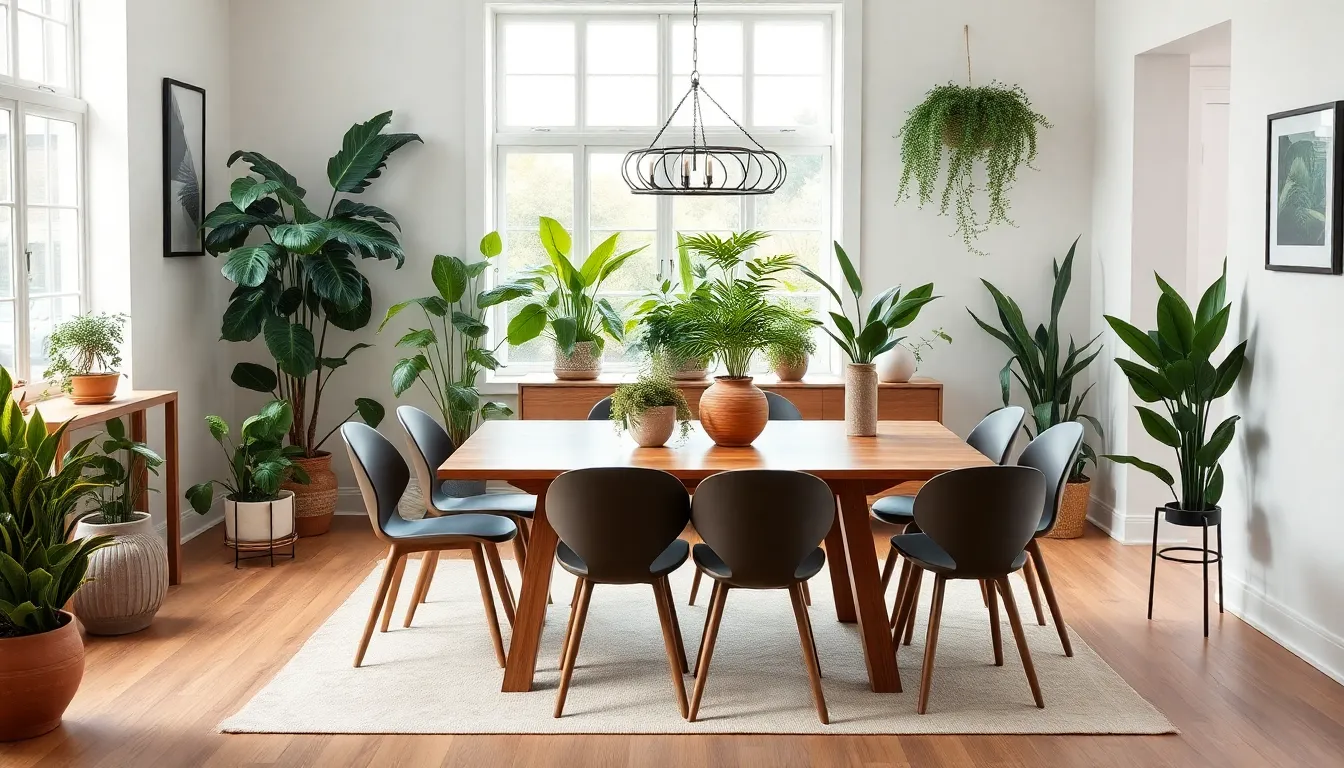
Transforming your dining room with plants requires thoughtful integration that enhances rather than overwhelms your existing decor. We’ll explore how to seamlessly blend natural elements with your design aesthetic through strategic container selection, color coordination, and proper plant sizing.
Match Plant Containers to Your Interior Design Style
Selecting the right containers creates visual harmony between your plants and dining room decor. Midcentury modern spaces benefit from sleek ceramic or minimalist pots that complement clean lines and geometric furniture pieces. Farmhouse and rustic dining rooms embrace terracotta planters or woven baskets that add warmth and texture to the space.
Contemporary interiors shine with glass vessels like repurposed spice jars or fish bowls that bring unique character while maintaining a streamlined appearance. Traditional dining rooms look elegant with classic ceramic planters in neutral tones that don’t compete with ornate furniture details. We recommend coordinating container materials with your dining table finish and hardware to create a cohesive look throughout the room.
Coordinate Plant Colors With Your Color Scheme
Plant selection should complement your dining room’s existing color palette for maximum visual impact. Warm wood tones pair beautifully with deep green foliage plants that provide striking contrast against rich furniture finishes. White and neutral interiors come alive with vibrant green or variegated plants that brighten the space without overwhelming the clean aesthetic.
Variegated foliage plants introduce natural pops of color that can echo accent hues from your textiles, artwork, or wall colors. We suggest selecting plants with leaves that contain subtle hints of your room’s secondary colors to create an intentional, designed appearance. Plants with burgundy or purple undertones work particularly well in dining rooms with similar accent colors in upholstery or decorative elements.
Balance Plant Sizes With Room Proportions
Proper plant sizing ensures your greenery enhances rather than dominates your dining space. Large statement plants like fiddle leaf figs or mother-in-law’s tongue work beautifully in spacious dining rooms or empty corners where they can create dramatic focal points. These floor plants add vertical interest and help define different areas within open concept layouts.
Smaller plants such as nerve plants, orchids, or succulents cluster effectively on sideboards or windowsills without overwhelming compact dining areas. Table centerpieces should feature low profile plants that maintain clear sightlines and encourage conversation flow during meals. We recommend grouping plants of varying heights to create visual depth while ensuring the tallest specimens don’t block natural light from reaching shorter varieties.
Maintain Healthy Plants in Your Dining Room Year-Round
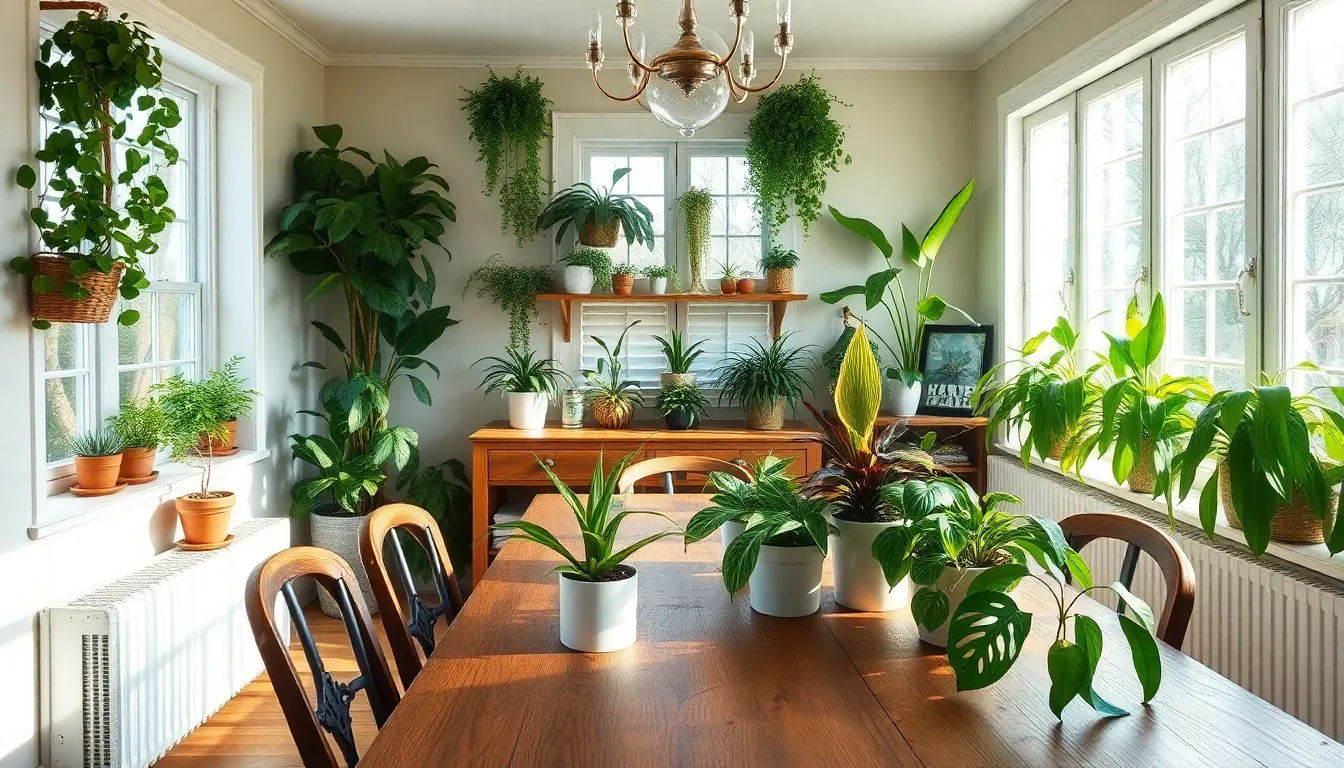
Keeping your dining room plants thriving throughout the seasons requires consistent attention and proper care techniques. We’ll guide you through essential maintenance practices that ensure your green companions remain vibrant and healthy.
Establish a Consistent Watering and Care Routine
Developing a regular watering schedule forms the foundation of successful plant care. Different plants have varying moisture needs, so we recommend creating a customized approach for each variety. Tropical plants typically need weekly watering, while succulents and cacti thrive with watering every other week or less frequently.
Linking plant care to your existing habits makes maintenance effortless. We suggest scheduling plant care after kitchen cleanup or on laundry day to build consistency. This approach ensures you won’t forget your plants during busy periods.
Using well-draining pots prevents waterlogging and root rot. We always choose containers with drainage holes to allow excess water to escape. Feeding your plants occasionally with balanced fertilizer supports optimal growth and keeps foliage lush.
Keeping a small plant care kit nearby simplifies maintenance tasks. Stock essentials like scissors, a watering can, and fertilizer in your dining room to reduce barriers to regular care.
Monitor for Pests and Plant Health Issues
Regular inspection helps catch problems before they become serious threats. We recommend checking your plants weekly for signs of pests or health issues like yellowing leaves, which often signal overwatering or disease.
Different plants have varying susceptibility to pest problems. Philodendrons are naturally less prone to pest issues, while other varieties might need more attention and preventive care.
Keeping plants clean maintains their vigor and prevents infestations. We suggest wiping leaves regularly and pruning brown or dying parts to promote healthy growth. This simple practice also improves the overall appearance of your dining room display.
Providing a monthly “plant spa day” rejuvenates your green collection. Flush soil with water, clean leaves thoroughly, and prune as needed to keep plants in peak condition.
Rotate Plants for Even Growth and Light Exposure
Rotating plants periodically ensures all sides receive equal light exposure. We recommend turning your plants a quarter turn every week to prevent uneven growth and encourage balanced foliage development.
Understanding your dining room’s lighting conditions guides plant selection and placement. Low-light tolerant species like Pothos or Peace Lily thrive in indirect light, while others require brighter settings for optimal health.
Strategic rotation prevents plants from leaning toward light sources. We’ve found that consistent rotation creates fuller, more symmetrical plant shapes that enhance your dining room’s aesthetic appeal.
Adjusting plant positions seasonally accommodates changing light patterns. During winter months, we often move plants closer to windows to compensate for reduced daylight hours, then relocate them as spring returns.
Style Your Dining Room With Plants for Different Occasions
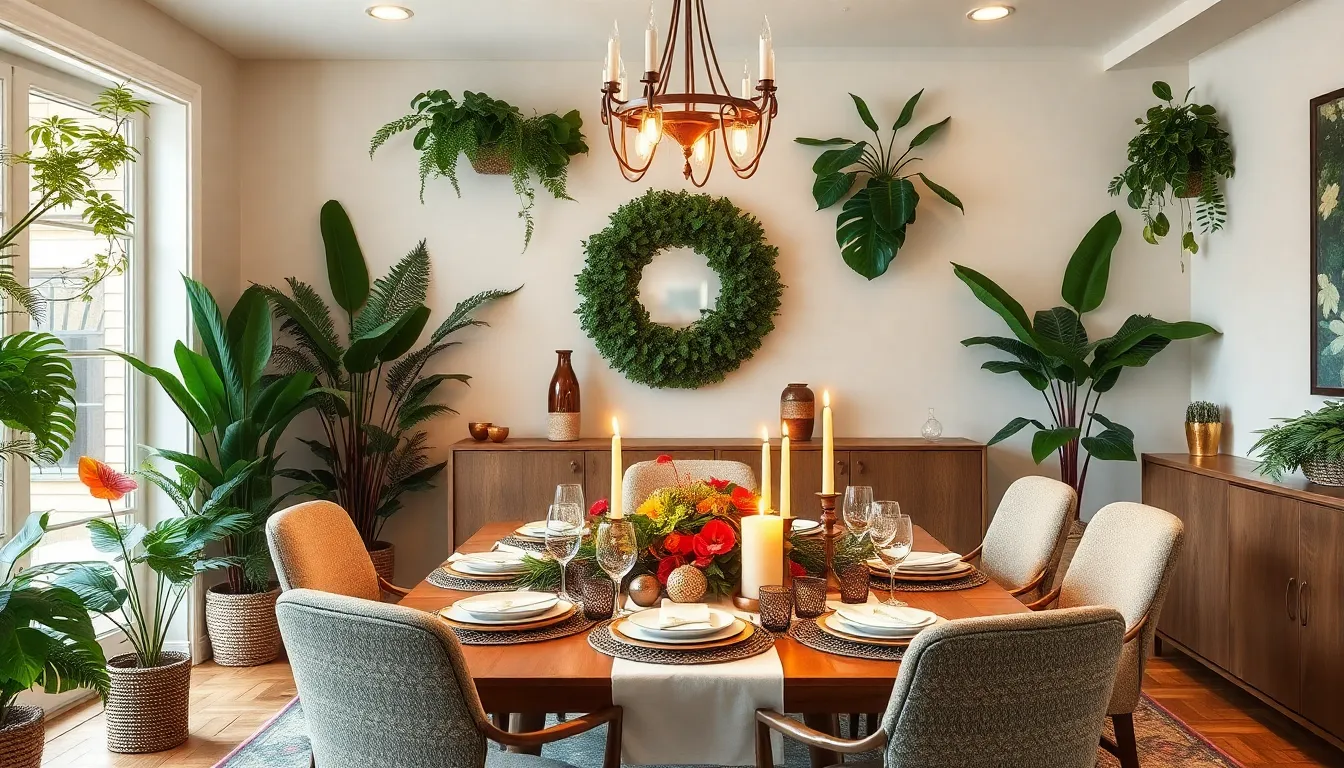
Different occasions call for fresh approaches to our dining room plant displays. Adapting our greenery arrangements helps create the perfect atmosphere for every gathering throughout the year.
Create Seasonal Displays With Rotating Plant Arrangements
Spring and summer displays benefit from fresh, leafy plants that reflect the vibrant growing season. We recommend using ferns, calatheas, or bright green palms that thrive in indirect sunlight during these warmer months. Succulents and cacti work perfectly for sunny spots, while flowering plants like Anthurium add pops of vibrant color that mirror the season’s energy.
Fall and winter arrangements should incorporate evergreens or plants with deep, dark green foliage like ZZ plants or snake plants. Adding seasonal accents such as pinecones or berries around plant pots creates visual interest without overwhelming the natural greenery. These additions reflect the season’s spirit while maintaining our plant displays as the focal point.
Rotating plants based on their blooming cycles and exact light requirements keeps our displays healthy and visually stimulating year round. Strategic plant rotation also ensures each variety receives optimal growing conditions during their peak seasons.
Design Holiday-Themed Plant Decorations
Christmas celebrations can feature our existing ferns, palms, or fiddle leaf figs embellished with small ornaments, fairy lights, or elegant ribbons. These subtle additions transform our everyday plants into festive focal points without requiring complete room makeovers.
Lush holiday centerpieces combine plants like Anthurium or tropical leaves with flickering candles for warm, inviting displays. Creating these arrangements using our established plant collection maintains consistency while adding celebratory elements.
Thanksgiving decorations incorporate autumnal foliage, dried leaves, or mini pumpkins arranged around our existing plants. This approach brings festive warmth to our dining space while preserving the natural, elegant look we’ve cultivated throughout the year.
Using plants as decoration bases unifies our holiday themes and keeps the dining area sophisticated without creating visual clutter.
Arrange Plants for Intimate Dinners Versus Large Gatherings
Intimate dinner arrangements work best with smaller potted plants or single statement pieces like Anthurium or Zanzibar Gem positioned as centerpieces. Low profile options such as ferns or calatheas soften the dining space and encourage relaxed conversation between guests.
Large gathering setups require multiple plant groupings distributed throughout the room rather than concentrating all greenery on the dining table. Positioning tall, leafy plants like Ficus Audrey or Lady Palm away from the dining surface adds height and drama while preserving essential space for tableware and food service.
Lighting considerations become crucial when adapting our arrangements for different occasions. Bright indirect light supports most leafy plants during daytime gatherings, while low light tolerant varieties like snake plants and ZZ plants excel in dimmer evening settings with ambient lighting.
Maximize Small Dining Spaces With Clever Plant Placement
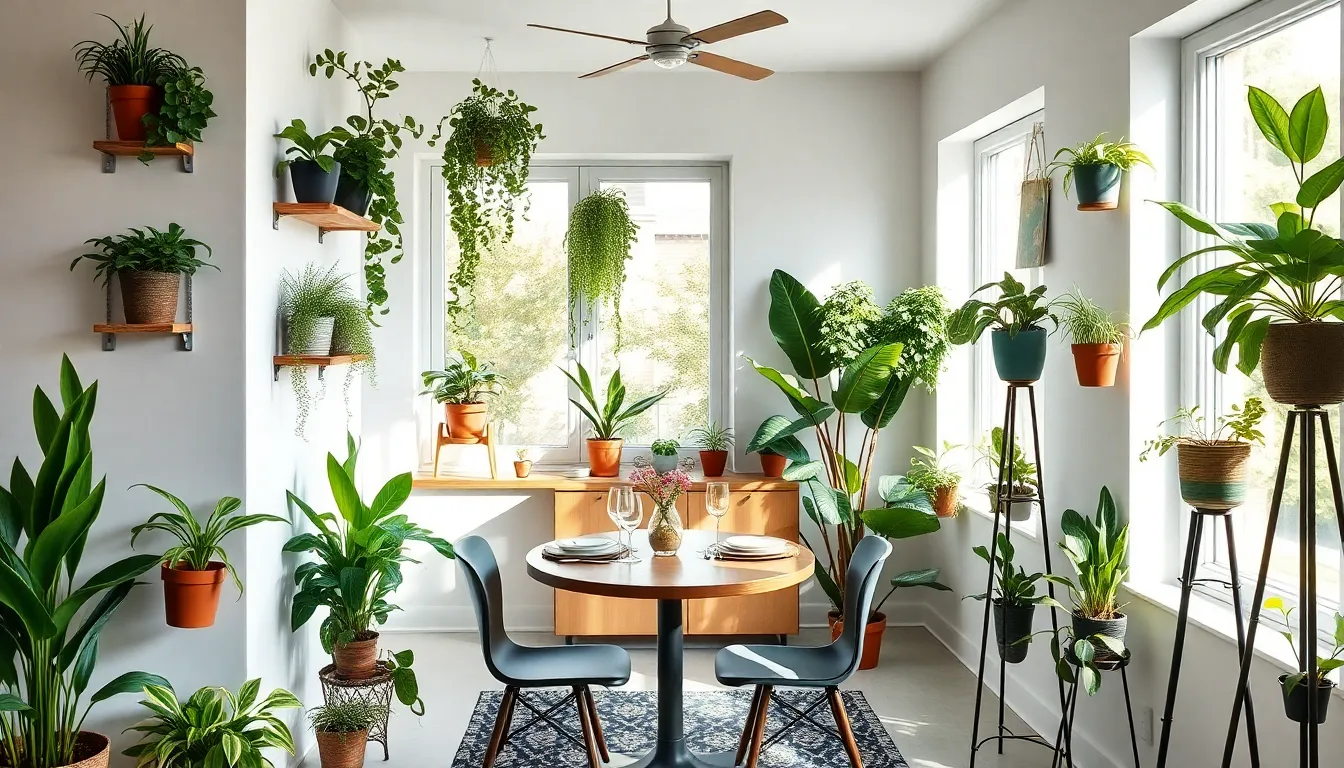
When space feels limited, we can transform our dining rooms into green sanctuaries by thinking strategically about plant placement. Smart positioning techniques allow us to enjoy lush greenery without sacrificing precious floor space or cramping our dining area.
Use Vertical Space for Plant Storage and Display
Wall mounted planters create stunning displays while preserving valuable floor space for dining chairs and movement. Multi level plant stands transform bare walls into living artwork, turning unused vertical areas into captivating focal points that draw the eye upward.
Hanging plants from ceiling hooks or mounted floating shelves near windows maximize light exposure while maintaining clear pathways around our dining table. Ceiling suspended planters work especially well above dining areas, creating a canopy effect that adds intimate ambiance without cluttering surfaces.
Tall plant stands elevate greenery to eye level, making small plants appear more prominent while utilizing corners that typically go unused. Vertical shelving units can house multiple plants at varying heights, creating a cascading garden effect that makes rooms feel larger and more ever-changing.
Choose Compact Plants That Don’t Overwhelm the Room
String of Pearls offers unique trailing bead like leaves that cascade beautifully from elevated positions while requiring minimal water and thriving in bright, indirect light. This compact succulent creates visual interest without demanding floor space or overwhelming smaller dining areas.
Peace Lily provides elegant white blooms and lush greenery in a manageable size, tolerating low to moderate light conditions while purifying indoor air naturally. We love how this plant enhances dining room comfort through improved air quality while maintaining a sophisticated appearance that complements any decor style.
Fiddle Leaf Fig serves as a striking focal point with large leaves that make a statement without spreading horizontally, thriving in bright, indirect light when positioned in corners or tall planters. Though larger than other options, its vertical growth pattern prevents it from overwhelming compact spaces when properly positioned.
Multi Purpose Plant Stands and Furniture Answers
Plant stands that double as side tables integrate greenery into functional furniture pieces, providing surfaces for drinks or serving dishes while displaying our favorite plants. These clever answers eliminate the need for separate plant and furniture purchases while maximizing utility in tight spaces.
Built in planters within dining furniture create seamless integration between plant display and dining functionality, combining storage with living decoration in innovative ways. Selecting pieces with integrated shelving allows us to showcase plants alongside dishes or decorative items without requiring additional floor space.
Convertible furniture pieces with planter components transform traditional dining setups into multi functional spaces that serve both practical and aesthetic purposes. We recommend choosing furniture that accommodates our exact plant collection while maintaining the flexibility to rearrange as our green thumb grows.
Conclusion
Transforming your dining room with plants isn’t just about decoration—it’s about creating a living space that nourishes both body and soul. We’ve shown you how the right greenery can turn any meal into a more enjoyable experience while improving your home’s air quality and overall ambiance.
The key lies in understanding your space and choosing plants that work with your lifestyle rather than against it. Whether you’re working with abundant natural light or cozy low-light conditions there’s always a perfect plant waiting to enhance your dining experience.
Remember that successful plant integration takes time and patience. Start small experiment with different varieties and don’t be afraid to move things around until you find the perfect arrangement. Your dining room will gradually evolve into the inviting sanctuary you’ve always envisioned.
Frequently Asked Questions
What are the benefits of adding plants to my dining room?
Plants enhance the dining room atmosphere by purifying the air, adding natural texture and color, and creating a more inviting gathering space. They serve as mood enhancers while bringing personality to your dining area, ultimately transforming it into a vibrant sanctuary that elevates your overall dining experience.
How do I choose the right plants for my dining room’s lighting conditions?
Assess your dining room’s natural light first. South-facing windows with bright light are perfect for fiddle leaf figs, crotons, and succulents. North-facing rooms with lower light suit pothos, snake plants, and ferns. Match your plant selection to available light for optimal growth and health.
Are there pet-safe plants I can use in my dining room?
Yes, many beautiful plants are safe for pets. Consider ferns, palms, spider plants, and Boston ferns. Avoid toxic varieties like pothos, fiddle leaf figs, and snake plants if you have pets. Always research plant toxicity and consider placing plants at heights pets cannot reach for added safety.
How should I arrange plants in my dining room for maximum visual impact?
Use larger statement plants in corners as focal points, layer plants of varying heights for depth, and group plants in odd numbers for visual appeal. Consider table centerpieces with low-profile plants, utilize vertical space with hanging planters, and ensure arrangements don’t obstruct conversation during meals.
What containers work best for dining room plants?
Choose containers that complement your dining room’s style. Sleek ceramic pots work well with modern decor, while terracotta planters suit rustic settings. Ensure containers have proper drainage and coordinate colors with your room’s palette. Size containers appropriately for both the plant and your space proportions.
How do I maintain healthy plants in my dining room year-round?
Establish a consistent watering routine based on each plant’s needs, use well-draining pots, and inspect regularly for pests. Rotate plants periodically for even growth, adjust positions seasonally for changing light patterns, and link plant care to existing daily habits to ensure regular attention.
Can I style my dining room plants for different seasons and occasions?
Absolutely! Use leafy plants like ferns and palms for spring and summer vibrancy, while incorporating evergreens and dark foliage for fall and winter. Add seasonal accents to existing plants for holidays, use smaller plants for intimate dinners, and create multiple groupings for larger gatherings.
How can I incorporate plants into a small dining room?
Maximize vertical space with wall-mounted planters and hanging plants. Use multi-level plant stands and tall corners effectively. Choose compact varieties like String of Pearls or Peace Lily. Consider multifunctional furniture like plant stands that double as side tables or built-in planters within dining furniture.

